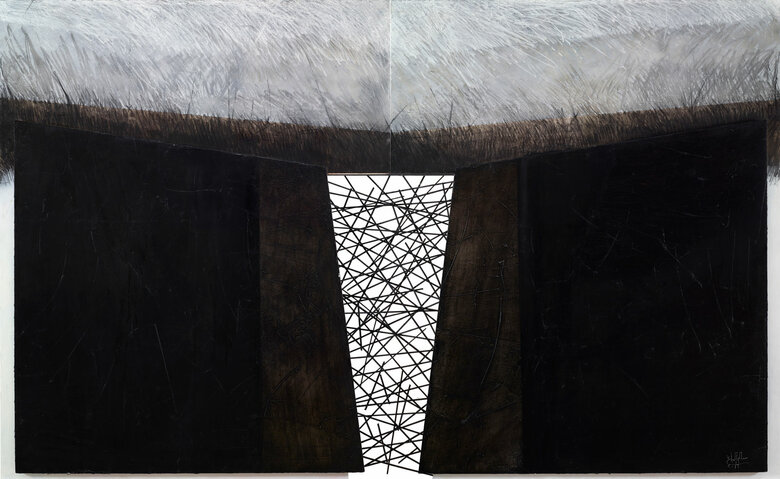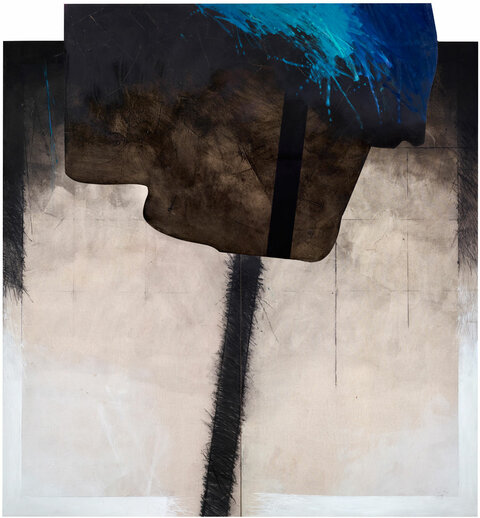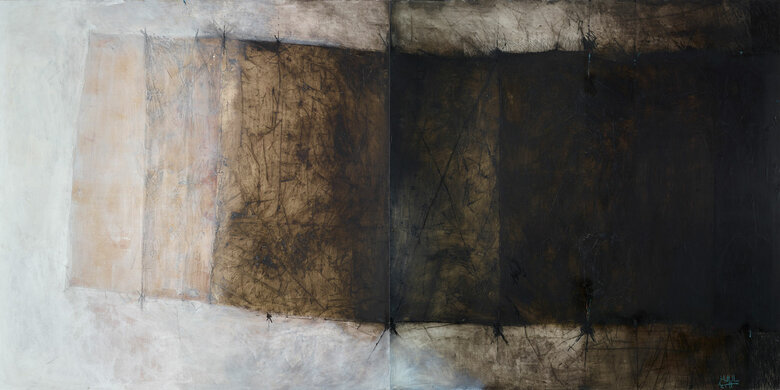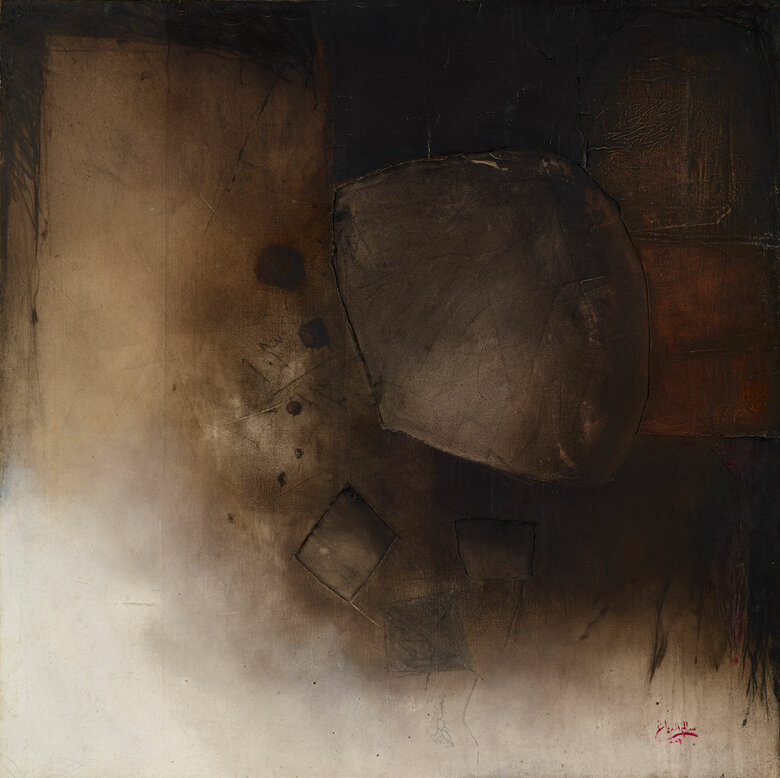Written by Mysa Kafil-Hussain Born in 1941, Salim al-Dabbagh is an abstract painter and printmaker who was born and raised in Mosul, Iraq. As a young man, al-Dabbagh had developed a love for the...
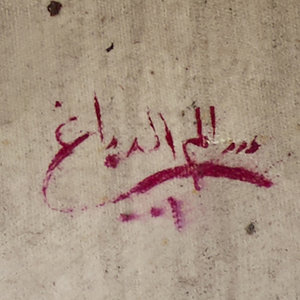

SALIM AL DABBAGH, Iraq (1941 - 2022)
Bio
Written by Mysa Kafil-Hussain
Born in 1941, Salim al-Dabbagh is an abstract painter and printmaker who was born and raised in Mosul, Iraq. As a young man, al-Dabbagh had developed a love for the traditions, cultures and crafts of the city, however it was by complete chance, following no distinct childhood passion for art, that he then became completely enamored by photographs he saw of Vincent Van Gogh’s work, sparking a love for painting which would continue for the rest of his life.[1] Al-Dabbagh’s growing interest soon became his educational pursuit, graduating from the Institute of Fine Arts in Baghdad in 1961, and then taking another course at the Academy of Fine Arts in Baghdad, graduating in 1965.[2] He was taught by a number of pioneering artists at the Institute, including Faik Hassan, Ismail al-Cheikhli and Jewad Selim, who had a great impact on his understanding of art. At the Academy, he was trained in a more academic manner, but was also in the presence of renowned European modernist artists, highly skilled in engraving, printmaking and mural paintings.[3] As one of the first Iraqi artists to be trained in the arts of engraving and printmaking, this would undoubtedly have an influence on a young al-Dabbagh, further developing his interest in abstraction and experimental art.
The mid-late 1960s was an eventful period in al-Dabbagh’s life and specifically his career, with his artwork gaining increasing attention. He and many artists of the time were keen to push their creative boundaries, resulting in al-Dabbagh becoming a founding member of a new art collective, The Innovationists (al-Mujadideen), in 1965.[4] He founded the group with other artists including Ali Talib, Faik Hassan, Saleh al-Jumaie and many others, with their collective intention to move on from the existing art movements in Iraq, connect with innovative global artists, and also to rebel against traditional styles, techniques and mediums, and especially encouraged younger artists to push the boundaries of their artistic practice.[5] Following a number of exhibitions, including an exhibition of political posters entitled ‘Resistance’ after the 1967 Six Day War,[6] al-Dabbagh and two other artists, Rafa al-Nasiri and Hashim Samarchi, were nominated by the Iraqi Artists Association for a scholarship with the Calouste Gulbenkian Foundation. The three artists left Iraq for Lisbon, Portugal, where they spent two years studying graphic art, exhibiting their work for local audiences during their stay. For al-Dabbagh, this experience propelled his creative mind even further into the world of the endless possibilities of abstract art, leaving a lasting impression on the artist, his styles and techniques.
“Abstract work is the only style that fulfils my ambition in attaining the qualities of imperceptible beauty”
Salim al-Dabbagh[7]
Upon his return to Baghdad, alongside Samarchi and al-Nasiri, al-Dabbagh began exhibiting his new work to Iraqi audiences, pushing graphic art into the mainstream of local artistic production. Following this, he and other Iraqi artists began participating in a number of international graphics biennales and exhibitions. In 1971, al-Dabbagh was offered a position at the Institute of Fine Arts, teaching drawing, planning and graphic art, and also serving as Head of the Graphic Design Department until his retirement in 2000. It was during his years as a teacher that he painted Jidār wa-Fadā’ in 1992, meaning ‘Wall and Space’. Using mixed media on canvas, part of his composition becomes an earthy, textured surface – what we can assume to be the ‘wall’ – leaping out of the canvas as though it were three-dimensional. It sits in the surrounding space, only connected by sharp lines and a blast of colour at the bottom of the painting. Al-Dabbagh often painted artworks with similarly rigid, conflicting sections, which artist and art critic Nizar Selim sees as antagonistic elements intended to have different dimensions and directions.[8]
There are four further artworks by the artist in the Dalloul Collection, including Khayma ba’d al-Qaṣaf (2001), meaning ‘The Tent after the Bombing’, one untitled work from 2012 and two from 2015. These compositions are all fantastic examples of al-Dabbagh’s dark, abstract style, creating mysterious, hazy atmospheres fragmented with contrasting black and white spaces. Al-Dabbagh himself asserts that the black and white prominence in his oeuvre is cultivated in his unconscious imagination, stating that “even in my dreams I only see in black and white,”[9] and that the empty spaces in his compositions are rooted in a feeling of emptiness he has at that point in time: “the more space grows in my paintings, the emptier I feel”.[10] Within these enigmatic and lonely canvases, al-Dabbagh often interrupts the vast spaces with shapes, usually square or rectangular, inspired by Bedouin tents he saw as a child, the structures and textures of which fascinated him throughout his life. The shapes of the tents can often be deciphered in much of his work, including his paintings in the Dalloul Collection, and is most interestingly evident in his untitled work from 2012, a mixed media composition on board in which the stark, intersecting lines create a sense of spontaneous structure and defence, whilst the suggestion of the rough texture of the fabric walls and roof, usually woven with goat hair in reality, can almost be felt without even to touching the artwork.
Al-Dabbagh left Iraq for Damascus after the occupation of Iraq in 2003 during a time of instability and fear, however he returned home after a number of years.[11]
He continues to live and work in Iraq to this day.
[1] Mady Hassan Neama (n.d.), "إستمرارية الإختيار عند الفنان سالم الدباغ", n.pag
[2] Artist Website (n.d.), “About – سالم الدباغ”, n.pag
[3] Neama (n.d.), n.pag
[4] Ibrahimi Collection (n.d.), “Salim Al-Dabbagh”, n.pag
[5] Neama (n.d.), n.pag
[6] Samia Touati (n.d.), “Salim al-Dabbagh”, n.pag
[7] May Muzaffar (n.d.), “Salim al-Dabbagh: Eloquence of Silence”, n.pag
[8] Nizar Selim (1977), “Iraq Contemporary Art: Volume 1 – Painting, p.174
[9] Neama (n.d.), n.pag
[10] Christies (2018), “‘Salim al-Dabbagh: Abstract Composition’ – Middle Eastern, Modern and Contemporary Art, London, 24 October 2018”, n.pag
[11] Muzaffar (n.d.), n.pag
Sources
May Muzaffar (n.d.), “Salim al-Dabbagh: Eloquence of Silence”, In Mathaf Encyclopedia of Modern Art and the Arab World, Encylopedia.Mathaf.org.qa. Accessed July 2020. www.encyclopedia.mathaf.org.qa
Neama, Mady Hassan (n.d.). "إستمرارية الإختيار عند الفنان سالم الدباغ", In ElSada.net. Accessed July 2020. elsada.net
Touati, Samia (n.d.). “Salim al-Dabbagh”, In Mathaf Encyclopedia of Modern Art and the Arab World, Encylopedia.Mathaf.org.qa. Accessed July 2020. www.encyclopedia.mathaf.org.qa
Artist Website (n.d.). “About – سالم الدباغ”, In SalimAlDabbagh.com. Accessed June 2020. www.salimaldabbagh.com
Ibrahimi Collection (n.d.). “Salim Al-Dabbagh”, In IbrahimiCollection.com. Accessed July 2020. ibrahimicollection.com
Christies (2018), “‘Salim al-Dabbagh: Abstract Composition’ – Middle Eastern, Modern and Contemporary Art, London, 24 October 2018”, In Christies.com. Accessed July 2020. www.christies.com
CV
Selected Solo Exhibitions
2005
Orfali Gallery, Amman, Jordan
1972
Sultan Gallery, Kuwait
Beirut, Lebanon
Lisbon, Portugal
Selected Group Exhibitions
2019
مركز الفنون Baghdad, Iraq
2014
A Tribute to Rafa Nasiri, Nabad Art Gallery, Amman, Jordan
2013
Tajreed, CAP Kuwait, Kuwait
Affordable Art Collecting, Art Sawa, Dubai, United Arab Emirates
2012
Forever Now: Five Anecdotes from the Permanent Collection, Mathaf, Arab Museum of Modern Art, Doha, Qatar
2010
Sajjil: A Century of Modern Art Exhibition, Doha, Qatar
2008
Iraqi Contemporary Art Exhibition, Dubai, United Arab Emirates
2004
Iraqi Contemporary Art Exhibition, Dubai, United Arab Emirates
2000
Journey through the Contemporary Arts of the Arab World: Mesopotamia/Iraq, Darat al-Funun, Amman, Jordan
1993
Three Iraqi Artists (with Himat Mohammed Ali & Karim Rassan Mansour), Abdul Hameed Shoman Foundation Hall, Amman, Jordan
50 Contemporary Arab Artists, Darat al-Funun, Amman, Jordan
1990
Seven Iraqi Artists (with Shakir Hassan Al Said, Saadi al Ka'bi, Muhammad Muhraddin, Rafa al-Nasiri, Ali Talib, & Ismail Fattah), Darat al-Funun, Amman, Jordan
Joint exhibition with Saadi Abbas, Kuwait
1988
Baghdad International Festival of Art: “Art for Humanity”, Saddam Arts Centre, Baghdad, Iraq
1987
Between the Tigris and the Euphrates, Institut du Monde Arabe, Paris, France
Cairo Biennale, Cairo, Egypt
1986
Norwegian International Print Biennale, Friedrikstad, Norway
Baghdad International Festival of Art, Baghdad, Iraq
1982
Second Baghdad International Poster Exhibition, Baghdad, Iraq
1980
Third World Biennale of Graphic Art, Iraqi Cultural Centre, London, United Kingdom
1979
Cagne-sur-Mer International Festival, Cagne-sur-Mer, France
1974
First Arab Biennale, Baghdad, Iraq
1972
Al-Wasiti Festival, Baghdad, Iraq
1971
Buenos Aires, Argentina
Gallery One, Beirut, Lebanon
1970
La Biennale Internationale de Gravure Contemporaine de Liège, Belgium
1969
International Graphic Biennale of Ljubljana, Ljubljana, Yugoslavia (now Slovenia)
1968
Exhibition of Paintings (Group exhibition with Rafa al-Nasiri & Hashim Samarchi), Galeria Gravura, Lisbon, Portugal
1967
Resistance, Baghdad, Iraq
1966
Second Exhibition of the Innovationists, Baghdad, Iraq
International Exhibition of Leipzig, Leipzig, Germany
1965
First Exhibition of the Innovationists, Baghdad, Iraq
Awards
1987
Bronze Medal, Cairo Biennale, Cairo, Egypt
1986
Inter Graphic Award, Berlin, Germany
1985
Miro Picasso Award, Arab Spanish Leage, Baghdad, Iraq; Madrid, Spain
1982
Honourary Award, Second Baghdad International Poster Exhibition, Baghdad, Iraq
1980
Inter Graphic Award, Berlin, Germany
1978
Golden Sail Award, Kuwait
1966
Honourable Mention, International Exhibition of Leipzig, Leipzig, Germany
Collections
Azzawi Collection, London, United Kingdom
Calouste Gulbenkian Museum, Lisbon, Portugal
Contemporary Art Platform (CAP), Kuwait
Hussain Ali Harba Family Collection, Torino, Italy
Ibrahimi Collection, Amman, Jordan
Khalid Shoman Collection, Amman, Jordan
Mathaf: Arab Museum of Modern Art, Doha, Qatar
Ramzi & Saeda Dalloul Art Foundation (DAF), Beirut, Lebanon
Ur Art Gallery Collection, Baghdad, Iraq
Press
التشكيلي سالم الدباغ: بعض الشباب باتوا يرسمون للتجارة وليس لغايات فنية
ikhnews.com, Arabic, 2012
سالم الدباغ.. "السواد لي وللآخرين البياض"
صلاح عباس
almadapaper.net, Arabic, 2016
الملتقى العراقي للثقافة والفنون يكرم الفنان سالم الدباغ
ابراهيم السواعير
alrai.com, Arabic, 2019
الفنان سالم الدباغ: جيلنا قدَّم أهم مكوِّنات الثورة الثقافية
خضير الزيدي
magazine.imn.iq, Arabic, 2020
سالم الدباغ الفنان الذي وصل بالرسم إلى خلاصاته الجمالية
فاروق يوسف
alarab.co.uk, Arabic, 2018
يعرض في دار الأورفلي: ألوان سالم الدباغ تحتاج الى عين نظيفة كي تغتسل بسوادها
addustour.com, Arabic, 2005
«معرض سالم الدباغ في جاليري الاورفلي.. «اقتفاء الأثر
alrai.com, Arabic, 2005
غرافيك متاحف العراق: معرض لـ 22 عملاً مستعاداً
alaraby.co.uk, Arabic, 2019
SALIM AL DABBAGH Artwork
Become a Member
Join us in our endless discovery of modern and contemporary Arab art
Become a Member
Get updates from DAF
Follow Artists
Save your favourite Artworks
Share your perspectives on Artworks
Be part of our community
It's Free!
We value your privacy
TermsCookiesPrivacy Policies
Become a Member
Get updates from DAF
Follow Artists
Save your favourite Artworks
Share your perspectives on Artworks
Be part of our community
It's Free!
We value your privacy
TermsCookiesPrivacy Policies
Become a Member
Get updates from DAF
Follow Artists
Save your favourite Artworks
Share your perspectives on Artworks
Be part of our community
It's Free!
We value your privacy
TermsCookiesPrivacy Policies
Welcome to the Dalloul Art Foundation
Thank you for joining our community
If you have entered your email to become a member of the Dalloul Art Foundation, please click the button below to confirm your email and agree to our Terms, Cookie & Privacy policies.
We value your privacy, see how
Become a Member
Get updates from DAF
Follow Artists
Save your favourite Artworks
Share your perspectives on Artworks
Be part of our community
It's Free!
We value your privacy
TermsCookiesPrivacy Policies

-SalemAlDabbagh-Front.jpg)
-SalemAlDabbagh-Front.jpg)
-SalemAlDabbagh-Front.jpg)
-SalemAlDabbagh-Front.jpg)
